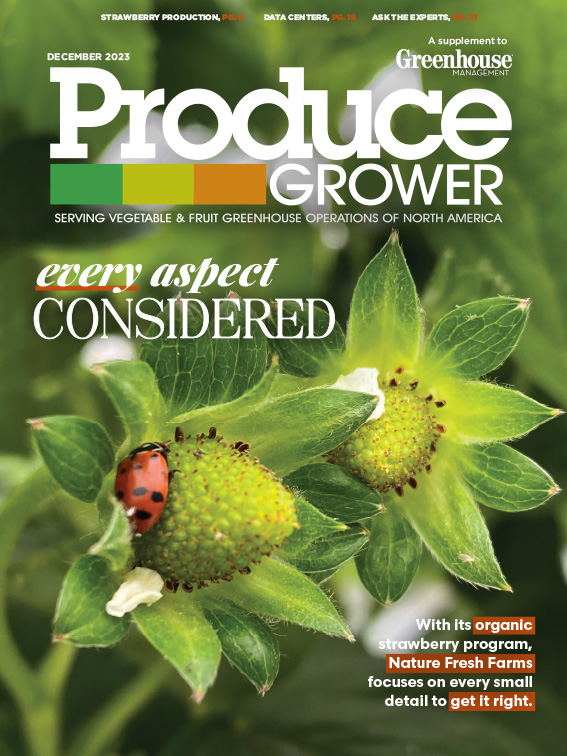
Every aspect of Nature Fresh Farms’ organic strawberry production is intentional.
Based out of Delta, Ohio, the company’s organic strawberry production encompasses 45-acres, separated from tomatoes grown elsewhere in the facility. Under supervision of director of growing operations Octavio Perez Rodriguez, there is a team managing everything from pollinators to scouting and anything else the crops need.
Rodriguez and other growers visited Holland three times to learn and train in the art of indoor berry production. They also trained in Canada and did roughly an acre of trialing there.
“We grew that crop for winter,” Rodriguez says, “and we learned a lot from that trial.”
“Nature Fresh Farms is always looking for ways to support our customers by listening to their challenges and addressing their concerns,” said Matt Quiring, senior vice president of sales & marketing at Nature Fresh, when the company announced the organic berries. “One such challenge was field berry supply, particularly ongoing weather and water challenges that continue to impact field growers, causing inconsistent supply. Our organic greenhouse berries address this concern, providing peak supply while field grown is most depleted and filling in supply gaps.
“Because of this,” he added, “greenhouse farmers are able to provide a more favorable crop that is consistent in flavor, freshness, quality and availability, and provide consumers with a fresher berry that is selected for taste and eating experience versus shelf life and transportability.”

Set up for success
Rodriguez says that the investment in training and trials before going online with organic berries was “a huge, huge help.” While he has been a greenhouse grower for well over a decade, the last time he produced berries was at university in his native Mexico.
“It was very, very helpful,” he says. “I think it was eye opening seeing it firsthand from those guys who have done it for at least more than five years. It was very good for us. We saw firsthand the different diseases, the pests, the challenges that the crop has in the winter. We saw how they light the crop and manage the crop. Then we got some contacts from them about how we got in touch with our consultant.”


At Delta, the strawberry production is divided up into three phases with each phase covering 15 acres. The production, Rodriguez says, sees the strawberries planted in a coco peat substrate. The crops arrive at the greenhouse as four-week-old plants.
There are 10 plants for every linear meter, which Rodriguez says is specifically for winter production. They also will use LED lighting to supplement natural sunlight to allow the berries to grow through the winter. The lights, he says, have been installed, but will not be used until winter. To avoid dormancy, the crops can receive at least 17 hours of light per day, Rodriquez explains.
“We have artificial light, and we have flowering bulbs,” he says. “The LEDs have a capacity of 266 micromoles per square meter and we have a similar capacity with flowering bulbs. The bulbs are the source of far-red light.” Far red light, research shows, has positive effects on strawberries. In some studies, plants are more open, so the plant is more receptive to light. A more open plant also is easier to reach for greenhouse laborers, as well as making air ventilation to the crop more effective.



Focusing on the details
Rodriguez says this organic strawberry production is entirely different from anything else he’s grown in his career.
“It’s night and day from tomatoes,” he says. “That’s conventional. This is organic. There are things that have been more difficult — especially nutrition wise — because we have the bioreactor that gives us the elements for the strawberries. It provides nitrates and phosphorus and potassium and calcium and magnesium. Other elements, like iron and zinc, are provided as needed. It’s allowed if you have a deficiency, you can use a fertilizer to fight that. When you grow conventional, you have these vast sources of fertilizer you can use and adjust the accuracy as needed. In organic, you can’t do that. The recipe is what it is.”
Organic strawberry production, Rodriguez says, is labor intensive — which makes having a trained team even more important. Because he and other growers cannot rely on traditional methods, they have to do things differently. That means scouting by hand and using sticky cards for different pests and diseases. Issues they work against include spider mites, thrips and aphids. They then use an integrated pest management strategy with beneficial insects to fight back. The beneficials, Rodirguez says, are sprinkled in by hand as needed. In certain spots in the row, there are also bees who are let out on a certain schedule to provide needed pollination.

“You have to change the way you think,” he says. “You have to scout a lot, find the hot spots and control those areas with beneficials.”
Picking also must be done by hand, with workers going up and down the lines to look to see what berries are ready for harvest. And to keep flavor, picked berries are kept in a colder area of the greenhouse once packed as they await shipment to Nature Fresh retail partners such as Kroger who will carry the product. The growing team also measures “everything possible,” Rodriguez says, every Monday.
“We measure how many berries the crop produced, how much the crop is growing, the leaf length,” he says. “Those three measurements will tell us if the crop is going in a good way or a bad way.”
All the work is worth it, Rodriguez says. A fully ripe organic strawberry from Nature Fresh — a deep red color, naturally sweet with no tartness on first bite, a firm, but soft texture — is the ideal strawberry taste.
“I just took a clamshell home, freshly harvested, from the greenhouse,” Rodriguez says, “and I bought one from the store of a field grown product. It’s completely different. Different taste, different firmness, freshness. Our berries are a different experience.”

Explore the December 2023 Issue
Check out more from this issue and find you next story to read.
Latest from Produce Grower
- UF/IFAS researchers work to make beer hops a Florida crop
- Nature's Miracle announces initial shipments of "MiracleTainer" series container farm
- Local Bounti opens new high-tech controlled environment agriculture facility in Pasco, Washington
- NatureSweet responds after ruling by U.S. Court of International Trade that invalidates tax on tomato imports from Mexico
- Former Danone executive becomes chief operating officer at NatureSweet
- FMI welcomes updates to WIC food package increasing fruit and vegetable benefits
- Passion grows progress
- U.S. Department of Labor finalizes farmworker protection rule





